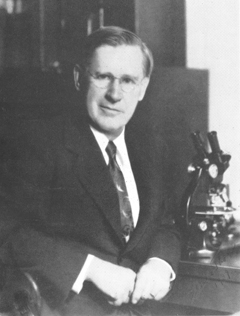
Penicillium is a genus of ascomycetous fungi that is part of the mycobiome of many species and is of major importance in the natural environment, in food spoilage, and in food and drug production.

Charles Thom was an American microbiologist and mycologist. Born and raised in Illinois, he received his PhD from the University of Missouri, the first such degree awarded by that institution. He studied the microbiology of dairy products and soil fungi, and in particular researched the genera Aspergillus and Penicillium. His work influenced the establishment of standards for food handling and processing in the USA. He pioneered the use of culture media to grow microorganisms, and, with food chemist James N. Currie, developed a process to mass-produce citric acid using Aspergillus. Thom played an important role in the development of penicillin in World War II.
Penicillium coprobium is an anamorph fungus species of the genus of Penicillium which produces pyripyropene A, roquefortine C, penicillic acid and patulin.
Penicillium corynephorum is an anamorph species of the genus of Penicillium.
Penicillium euglaucum is a species of the genus of Penicillium which was isolated from soil in Argentina.
Penicillium flavigenum is a species of the genus of Penicillium which produces penitrem A, penicillin and roquefortine C.
Penicillium formosanum is a species of the genus of Penicillium which produces patulin and asteltoxin.
Penicillium freii is a psychrophilic species of the genus of Penicillium which produces xanthomegnin and patulin. Penicillium freii occurs in meat, meat products, barley and wheat
Penicillium glaucoalbidum is a species of the genus of Penicillium.
Penicillium javanicum is an anamorph species of the genus of Penicillium which produces xathomegnin.
Penicillium lineatum is a species of the genus of Penicillium.
Penicillium marinum is a species in the genus Penicillium which produces patulin and roquefortine C.
Penicillium miczynskii is a species of the genus Penicillium which was isolated from soil under conifers in Poland. Penicillium miczynskii produces citreoviridin.
Penicillium olsonii is an anamorph, filamentous species in the genus Penicillium which produces several polygalacturonases, xanthoepocin, asperphenamate, verrucolone, phthalate and olnacin. Penicillium olsonii is an often source of spoilage of tomatoes, salami and beans This species occurs ubiquitously in soil
Penicillium osmophilum is a species of fungus in the genus Penicillium which was isolated from agricultural soil in Wageningen in the Netherlands
Penicillium palitans is an anamorph species of fungus in the genus Penicillium which was isolated from cheese and ancient permafrost deposits. Penicillium palitans produces viridicatin, cyclopiazonic acid, roquefortine, palitantin and ochratoxin A
Penicillium paneum is a species of fungus in the genus Penicillium which can spoil cereal grains. Penicillium paneum produces 1-Octen-3-ol and penipanoid A, penipanoid B, penipanoid C, patulin and roquefortine C
Penicillium roseopurpureum is an anamorph species of fungus in the genus Penicillium which produces Carviolin.
Penicillium tulipae is a species of fungus in the genus Penicillium which produces penicillic acid, roquefortine C, roquefortine D, terrestric acid, glandicoline A, glandicoline B, meleagrin, oxaline, penitrem A and epineoxaline.
Penicillium commune is an indoor fungus belonging to the genus Penicillium. It is known as one of the most common fungi spoilage moulds on cheese. It also grows on and spoils other foods such as meat products and fat-containing products like nuts and margarine. Cyclopiazonic acid and regulovasine A and B are the most important mycotoxins produced by P. commune. The fungus is the only known species to be able to produce both penitrem A and roquefortine. Although this species does not produce penicillin, it has shown to have anti-pathogenic activity. There are no known plant, animal or human diseases caused by P. commune.

